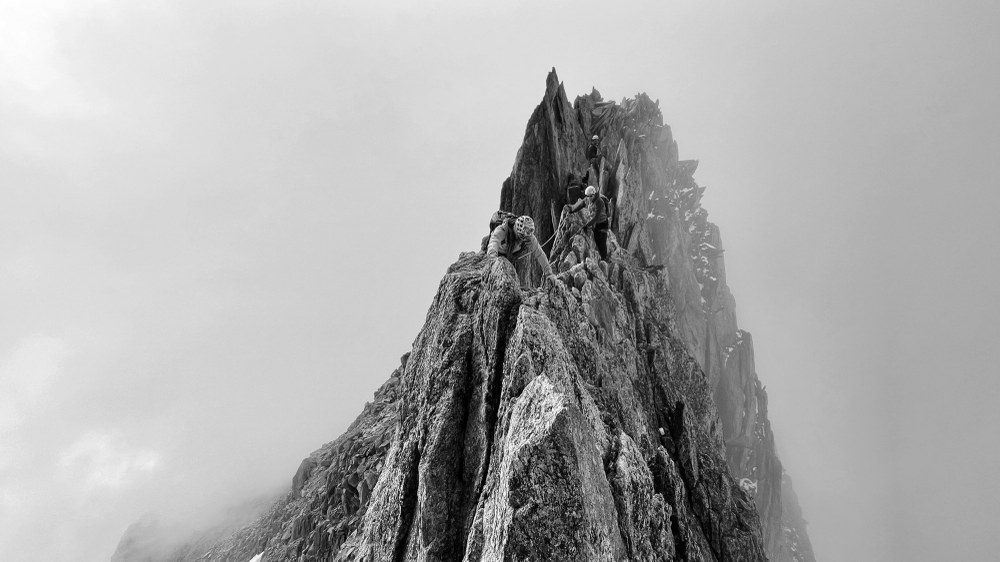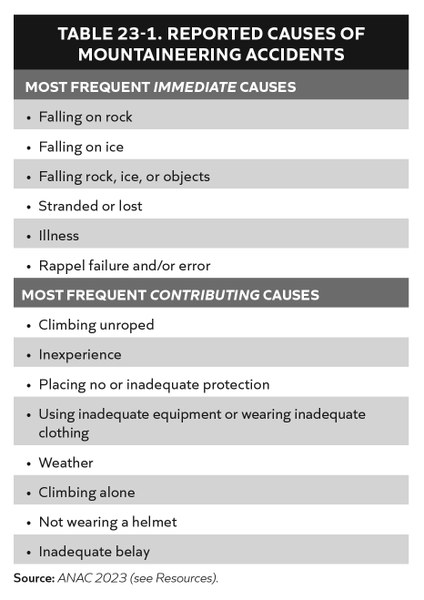
When I joined The Mountaineers nearly two and a half decades ago, I was motivated - in no small way - by the biggest criticism I had heard about the organization: "They are too safety conscious." I became a Mountaineers member shortly after a guided climb up Rainier, involving many unfamiliar skills and techniques. In my first Mountaineers course, safety was the opening topic. If you can’t be safe, you can’t have fun. That’s the heritage of The Mountaineers.
The evolution of safety and risk management
The Mountaineers early climbing programs are best captured in the initial Climber’s Notebook. These notes, transcribed by Wolf Bauer, served as the original blueprint for our climbing curriculum, eventually codified into Mountaineering: The Freedom of the Hills. Covering topics such as gear, belays, anchors, and snow travel, the Climber’s Notebook focused intently on tools and techniques. However, there was no dedicated chapter on safety nor guidance on outdoor hazards and risk management. In a quick scan of my own copy, I don’t even see the word “safe.” Safety was certainly part of the training, but it wasn’t emphasized as central to learning these skills.
In the ninth edition of Freedom of the Hills, “safe” or “safety” appear nearly seven hundred times, including a chapter dedicated to safety. While drafting the tenth edition, my fellow contributors and I made a deliberate choice to use these terms less. Our intent was not to eliminate the concept of safety, but to reframe safety, emphasizing personal responsibility and judgment. There is inherent risk in any activity. An individual shouldn’t assume they are free from harm because they are in a situation labeled as “safe.” Each climber must evaluate and be responsible for their own decisions.

Rather than label anything "safe," we use phrases like "safer than some other choice," "best practice," and "poses less risk." This reframing - made in tandem with an increased focus on decision making in the outdoors - recognizes that if individuals have the necessary information, they can make informed decisions to minimize risk. The very first section of Freedom of the Hills, led by venerable outdoor leader and navigation educator Peter Hendrickson, covers foundational topics for decision making.
From first steps through the basics of equipment, clothing, conditioning, and navigation, readers are presented options and guidance for making decisions related to each of these essential concepts.
Individual and group risk management
For the tenth edition of Freedom of the Hills, we replaced the chapter on safety with a new chapter on risk management. Bill Ashby, our organization’s longtime Safety Committee Chair and member of our Risk Management Committee, has done an excellent job presenting a framework for hazard analysis and mitigation strategies. This framework directs focus back to the responsibility of the individual, ensuring all members of a group share in risk management and are prepared when situations change or accidents happen. Along with risk management, readers will learn about skills associated with leadership, first aid, and self-rescue, led by former Kitsap Branch Chair and Olympic Mountain Rescue member Jerry Logan.
The concept of managing your own and your group’s risk is covered not only in one chapter or section, but woven throughout the entire tenth edition: avalanches, big wall climbing, sport climbing, snow travel, and more. For each of these activities, you must prepare and plan thoroughly, asking a series of questions. What hazards do you face? How can you evaluate them? How can you reduce your risk and improve your chances of a successful and enjoyable outing? Keeping these questions front of mind is the responsibility of each individual to ensure adequate preparation for the group as a whole.
Evolution in climbing safety
Freedom of the Hills is an instructional guide for novice and experienced outdoor enthusiasts alike. In the tenth edition of Freedom, contributors recognized the need to adjust instructional guidance, acknowledging how climbing has changed over the years. Led by Nick Hunt (former RMI guide and SIG leader for our Basic Alpine course) and Ian Nicholson (IFMGA-certified guide), with extensive input from Steve Swenson (longtime expert climber and two-time Piolet d'Or winner), the rock climbing sections were reorganized and heavily revised to better reflect how modern climbers progress in the twenty-first century, often starting in climbing gyms, transitioning to sport climbing, learning how to place trad gear, then tackling multipitch climbs as well as alpine climbs and snow travel.
In Steve’s remarkable contributions to the chapters about snow, ice, alpine, and expedition climbing, he not only clarifies climbing concepts but highlights specific risks associated with advanced topics. These contributions are particularly evident in the chapter on expedition climbing, which covers everything from initial planning stages to ensuring all team members return home unharmed. Before embarking on an expedition, groups should always discuss and agree upon a set of values to adhere to during their climb. Steve quotes renowned British alpinist Roger Baxter-Jones: "Come back alive, come back as friends, get to the top - and in that order."
This is the mission of each edition of Freedom, the tenth edition being no different: to help you experience a lifetime of freedom in the hills.
Eric Linxweiler learned about The Mountaineers when he bought Freedom 5 in Columbus, Ohio. After moving to Seattle in 2001, he joined The Mountaineers and enrolled in their climbing programs, teaching field trips, and mentor groups. He served as Board President when the organization moved to Magnuson and hired our new executive director. He also served as Vice President of Publishing and Branches. After expertly guiding two editions of Freedom through editing and production over the past eight years, he looks forward to recruiting the next volunteer editor for the eleventh edition. Contact him at freedomofthehills11@gmail.com.
This article originally appeared in our fall 2024 issue of Mountaineer magazine. To view the original article in magazine form and read more stories from our publication, visit our magazine archive.
 Eric Linxweiler
Eric Linxweiler
